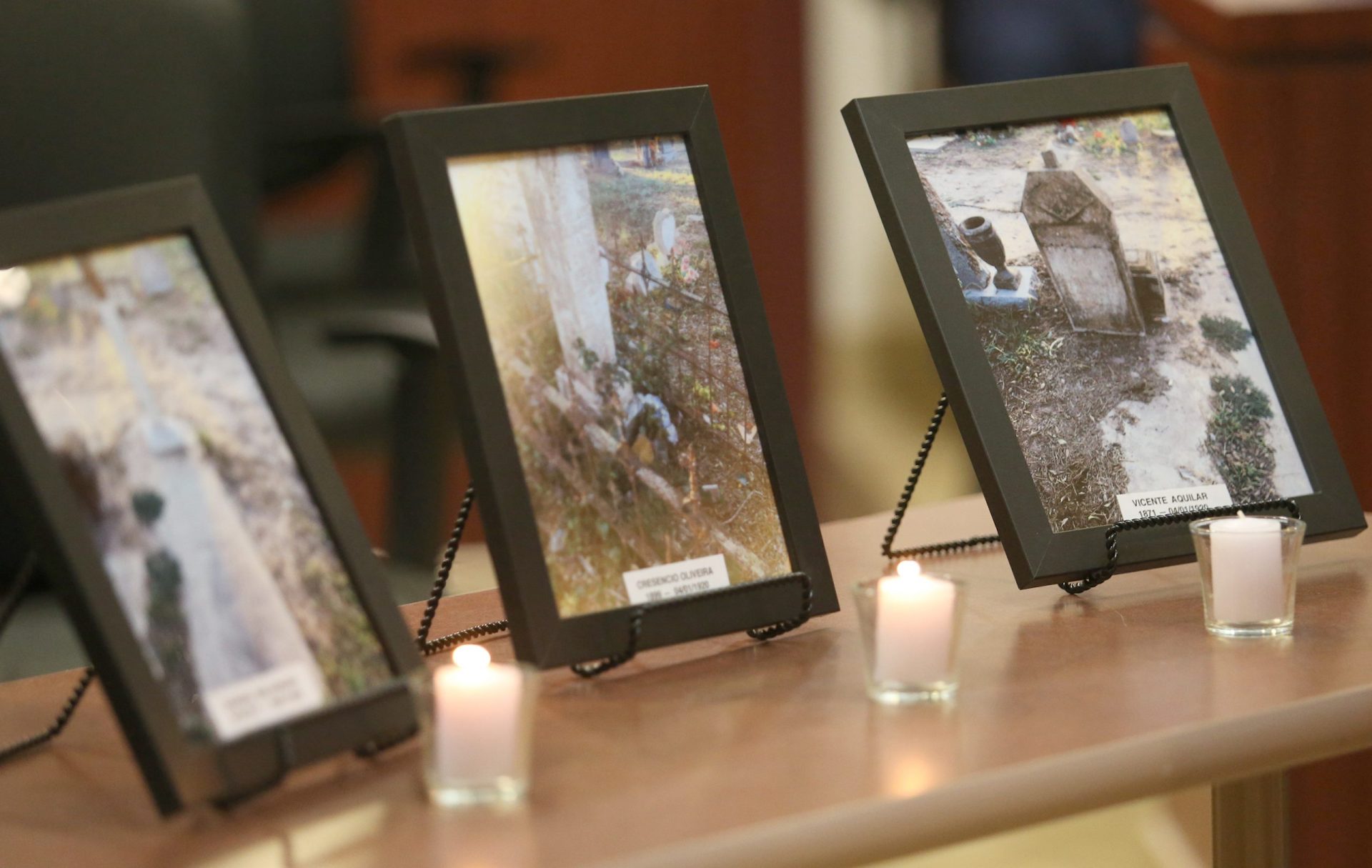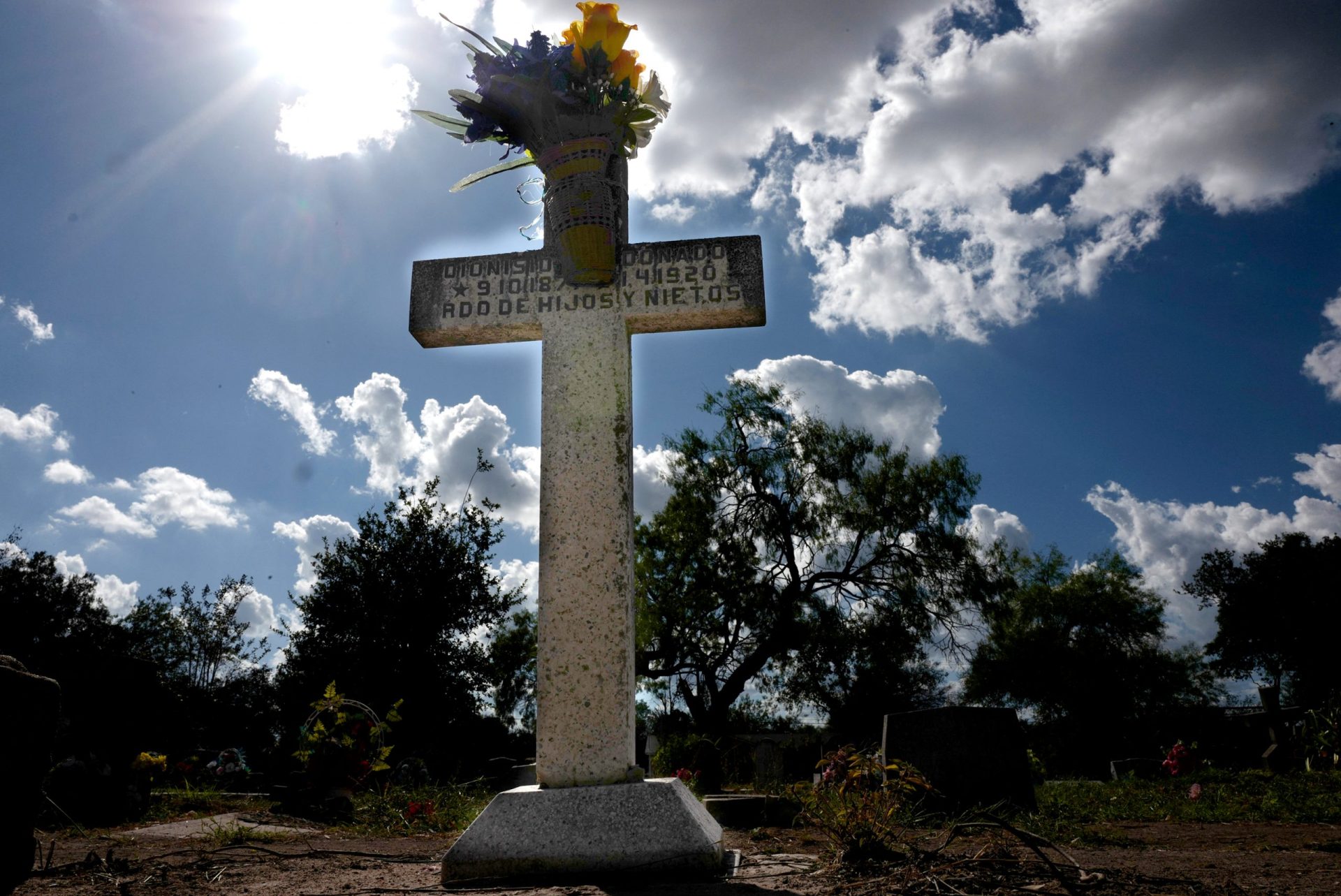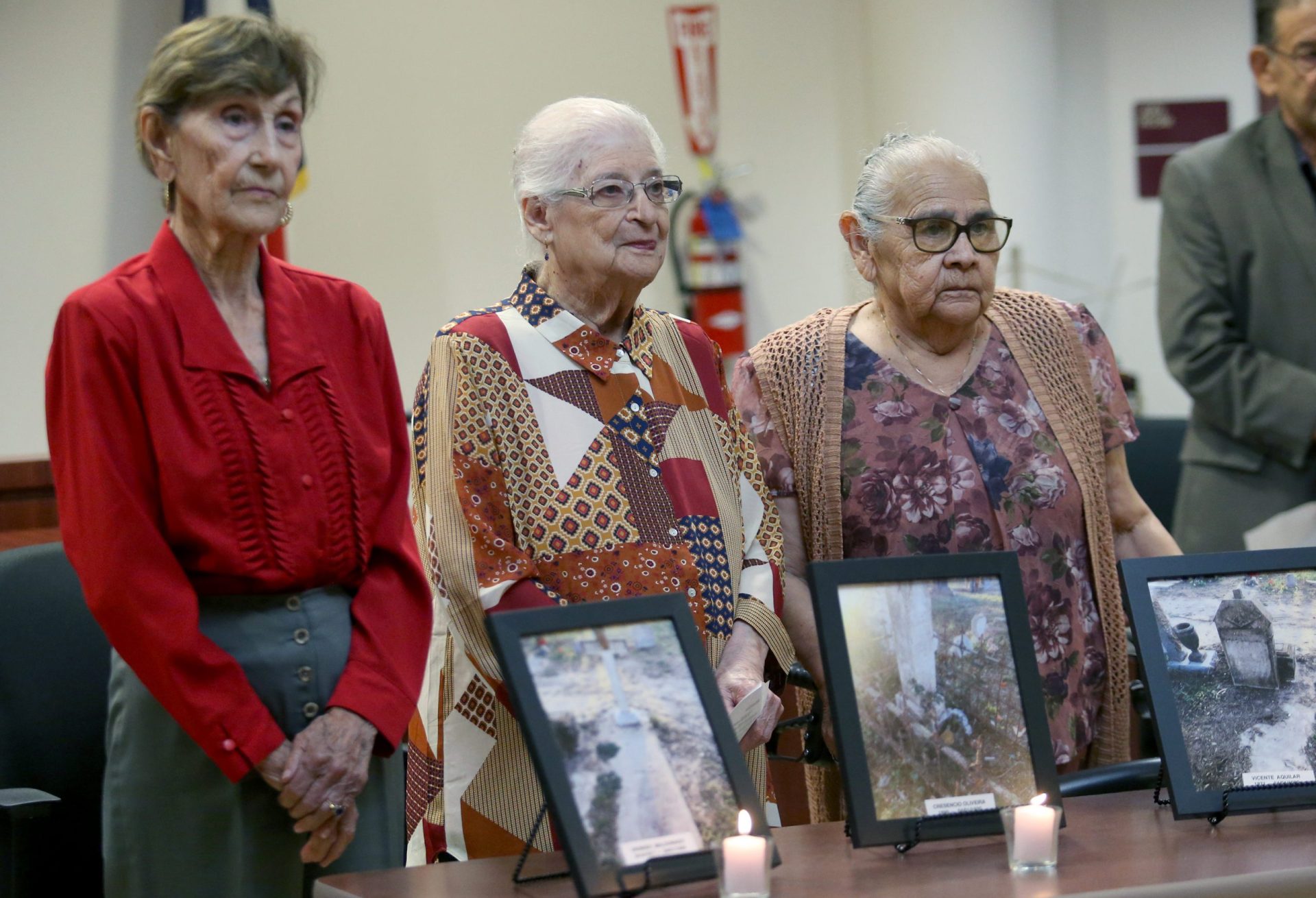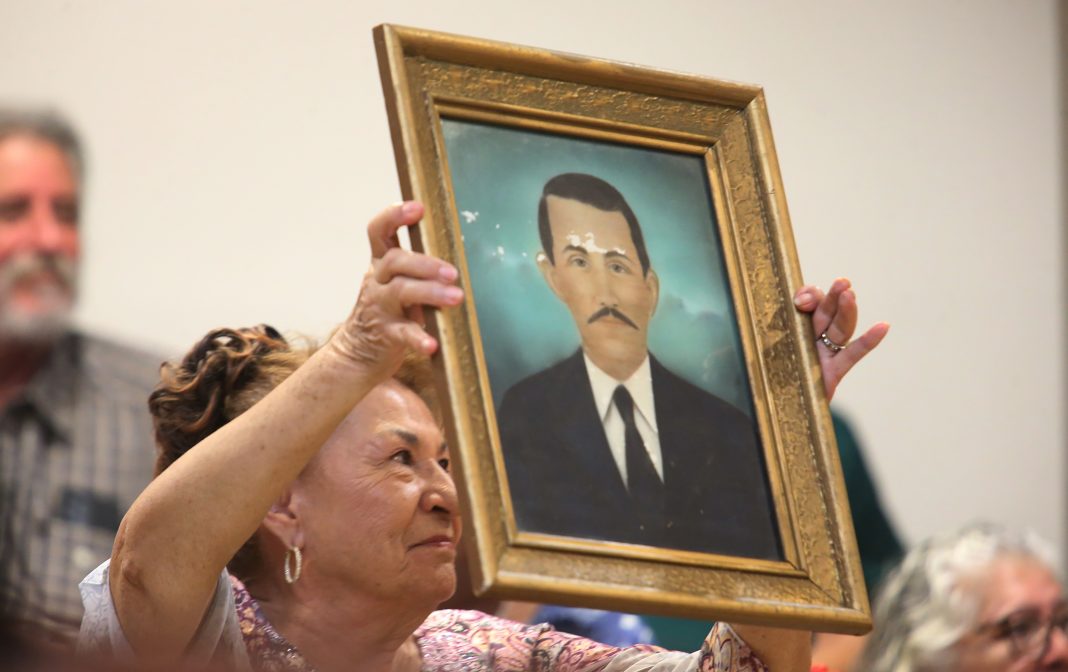SAN DIEGO — There lives a tale in the brushland between Benavides, Texas, and Parás, Mexico, a story of injustice and heartbreak that’s been often sung but seldom written.
That legend describes the shootings of three men: Crescencio Oliveira Jr., Dionisio Maldonado and Vicente Aguilar.
Texas Rangers killed them 102 years ago.
It’s a tragic ballad of a wedding party that was gunned down on the road to Parás, leaving three men — one of them the groom — dead in the dust by a watering hole near Bruni.
The story is an alternate account to the official narrative from 1920 that describes the men as a band of bootleggers killed by Texas Rangers while they were committing a crime.
It’s also, as historians and those men’s families say, the truth — a truth kept alive for a century by the families and defiant corridos that told of their demise at the hands of Los Rinches, or Rangers.
That truth took a significant step toward legitimacy last month at the Duval County Courthouse.
A crowd of about 200 crammed into the courthouse for the reading of a proclamation drafted by the Duval County Historical Commission and signed by a county judge.
That proclamation does not mince words.
It says unequivocally that those three men were murdered. It also honors their memory and contends that “justice against the Texas Rangers was never resolved.”
“People want to know about the history,” Interim Duval County Judge E.B. Garcia said.

For many of the people present during the proclamation’s reading, it was very much their history. Most were descendants or relatives of the men, some of the older ones still-living granddaughters.
They wept at times, laughed at others.
Many came from out of state or from Mexico. It was an extended family reunion with a passionate desire to set the record straight about their ancestors.
“We are deeply honored and we are so grateful because this is allowing us to reconnect as family and as friends,” Marianella Quiroga Franklin, the great-grandaughter of Dionisio Maldonado and a Rio Grande Valley resident, said. “Here we are 100 and some years later and the Oliveiras, the Aguilars and the Maldonados are still together. We are one big, strong, resilient family.”
A contemporary account printed days after the shootings in the Laredo Weekly Times describes the tragedy and the lie that has bound the men’s descendants for a century.
That article describes a “pitched battle” between customs inspectors and members of a “smuggling gang” that occurred about 4:30 p.m. on April 1, 1920, some 40 miles southeast of Laredo.
It alleges those men — “Mexicans,” it says — fired on a group of customs inspectors.
“The American Inspectors quickly responded to the fire and a pitched battle ensued, at times the opposing parties being less than forty feet apart. Two of the Mexicans who had dismounted and one of those who fired from horseback were killed, while the other four turned their horses and dashed into the chaparral.”
The account notes that two rifles, a revolver and some ammunition were found in the dead men’s saddlebags, along with provisions and “new shoes purchased in Benavides.”
They were buried near where they were killed, it says, claiming they were returning to Mexico after smuggling liquor somewhere or another. The story doesn’t name any of the dead men.
Another article speculates the men may have been smuggling arms or ammunition into Mexico, without citing any evidence to back up that claim.
In Border Contraband: A History of Smuggling across the Rio Grande, UTRGV Associate Professor of History George Diaz notes factors of that account that support the alternate version of events that the mens’ descendents have kept alive for generations.
“The new shoes that law enforcement discovered were intended as wedding presents, whereas the two rifles and revolver the dead men possessed were nothing more than their sidearms,” he writes. “Ethnic Mexicans’ version of events is indirectly supported by English-language newspapers, which inform that law enforcement recovered no alcohol from the victims.”
That alternate account has largely been kept alive in corridos, sometimes truncated or rearranged.
It says Oliveira, Maldonado and Aguilar were part of a wedding party. Oliveira was to be married to Maria de Jesus “Chucha” Gutierrez in Parás.
In a version of one corrido, the men arrive near Bruni and Maldonado dismounts to unlocked a gate. They’re set upon by “rinches de Laredo,” and Aguilar is wounded.
“Fuerzas son las que me faltan, valor siempre lo he tenido,” it says. He lacks strength, but not courage.
A mounted Oliveira gives his horse rein. “Entrenle, rinches cobadres, a pelear con este gallo,” he says, welcoming the “cowardly Rangers” as he meets his end.

At the proclamation ceremony at the Duval County Courthouse, balladeers sang a corrido of the men, adding a line about “Mi Chucha,” the woman Oliveira would never marry. The line was recounted to the musicians by one of the men’s granddaughters who met Chucha.
The oral history holds that two men escaped the shootings, not four. Still, the bodies of Oliveira, Maldonado and Aguilar “had to be recovered for burial secretly at night for fear of reprisal,” the historical commission’s proclamation said.
Ultimately the men were buried in the Benavides cemetery, somewhat ramshackle these days. Repairs are underway, Simon Saenz, a volunteer, says.
Saenz was on hand near the cemetery in October, the day the proclamation was read. He’d heard about the ceremony in San Diego and suspected someone might need to be led to the men’s graves.
Aguilar and Maldonado lie beside one another. Aguilar’s tombstone has fallen off its plinth. Oliveira lies apart; Saenz says he’s not sure why.
Standing by the graves, Saenz recalls the corrido and sings a verse from memory, clenching a fist and stretching out Maldonado lyrically.
“That’s what we used to sing, growing up,” he says.
Christopher Carmona, an associate professor at Our Lady of the Lake University and a Donna native who spoke at the ceremony, says it’s not unusual that the men were killed. Many died in La Matanza, a massacre led by Texas Rangers against ethnic Mexicans that Carmona says supported an anglo land grab in South Texas 100 years ago.
“This was not an isolated event,” Carmona said, noting Rangers frequently performed customs at that time in lieu of a federal agency. “There was estimated to be thousands from 1910 to 1920 that were murdered. Lynched.”
What’s more unusual is that the legend of Oliveira, Maldonado and Aguilar survives. Oliveira and Maldonado were both prominent citizens and landowners, which Carmona says likely contributed to the story’s popularity. Versions were being sung soon after the killings, he says, and were recorded in the 1930s.
The killings in Bruni have not, however, significantly entered the historiography of La Matanza. For lack of a better measure, the Porvenir massacre in West Texas and the killings of Jesus Bazan and Antonio Longoria in South Texas both have Wikipedia entries.
Those killings are also described by the Texas Historical Commission and have earned historical markers.
Oliveira, Maldonado and Aguilar are remembered almost solely by their corridos and their families.
Carmona says the Duval County proclamation about their killings is significant and possibly unique.
“It is the first time, and it’s rare,” he said. “Hidalgo County has not officially stated a proclamation for the murders of Bazan and Longoria either, even though we got a historical marker for that. The state of Texas has not acknowledged the Texas Ranger wrongdoing.”
The Texas Department of Public Safety, under which the Texas Rangers now fall, has no stance on the killings or the proclamation.
“There is no relationship between the modern Texas Rangers (or DPS) and the incident you reference,” the law enforcement agent said in a statement. “The modern-day Texas Rangers are comprised of principled men and women of great skill and integrity who are fully committed to the rule of law.”

Carmona is dubious of any kind of statewide recognition. The Texas Rangers will mark its bicentennial next year, he observed. Murder does not make good press.
For the men’s descendants, the memory of the killings is a more nuanced narrative than a crusade against the legacy of the Texas Rangers.
Maldonado’s great-granddaughter, Franklin, noted that her family includes several law enforcement officers.
“It is ironic that something so horrible that happened then has brought us to this today,” she said. “And so we’re not here in judgment…but we really like to bring out the beauty of this horrific incident. And the fact that here we are today — look at how many.”
There was a portrait of Maldonado at the ceremony — a dapper man in a suit, slender, with arched eyebrows and a thin mustache. His descendants held it as they sang corridos about him and Aguilar and Oliveira. To them, they were more than just victims or symbols of ethnic violence.
Oliveira, Maldonado and Aguilar were living, breathing men, with families and legacies greater than the way they died.
Their families want more than anything, Franklin said, for those men to be remembered — and remembered accurately.
To see more, view Monitor photojournalist Delcia Lopez’s full photo gallery here:
Photo Gallery: Families remember ancestors killed by Texas Rangers in 1920




